...Of Mice and Men – 75th Article Special – SSR Tamiya TT-01 3Racing E35 Career Review - Part 2
Part 2 of my Tamiya TT-01 career review switches things up a gear as the on-track action and competition increases and the cars are pushed to their developmental limits. Looking at the highs, the lows and the final races of the little car which delivered against the opposition.
By Sean Smith
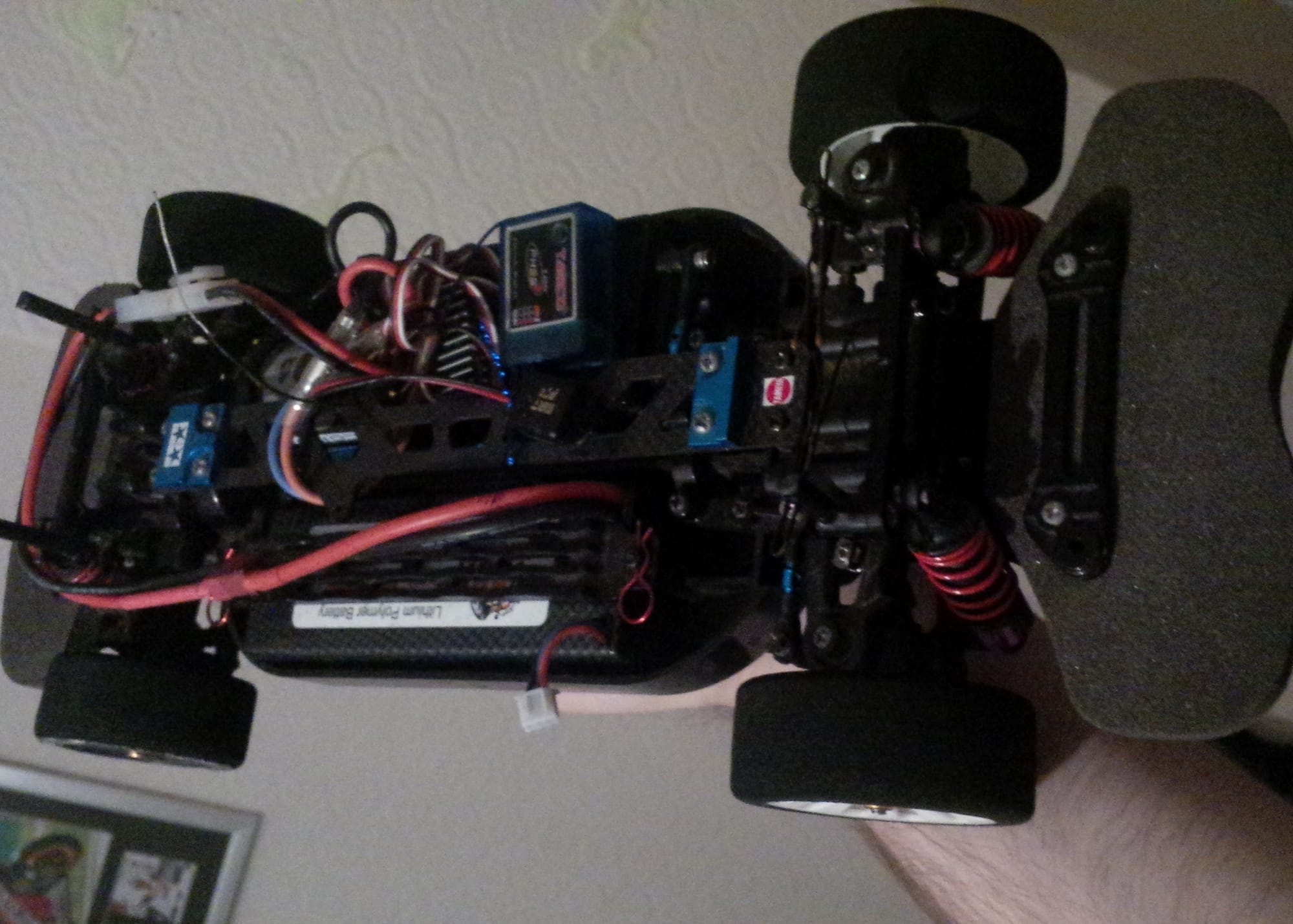
The Breakout Year.
January 13th 2015. That’s the date things got serious for the SSR Tamiya TT-01. On that day, I made a pair of changes to the car which would revolutionise the performance of the car. Firstly, I took off the red rubber tyres. As good as they had been, they allowed the car to understeer and be hard to turn in on corner entry when braking from a high speed, I fitted a set of foam ‘Contact’ carpet-tyres in their place but, more importantly, secondly, I added a rear wing to the “Feerari EXX” body shell to try and add downforce to the back end of the car.
The Tamiya TT-01 is not a natural-born race car. I’ve finally admitted it. It is Tamiya’s lowest rung on the ‘Touring Car’ RC ladder with its plastic ‘bathtub’ chassis, very limited adjustability and gearing which doesn’t allow you to get up to the take-off velocities of the cars it’s up against are capable of. What it is though is predictable. If you can get the TT-01 anywhere near a good operating window where the steering is pointing in a straight line and everything is screwed tightly into place, you can be sure that the car will do what it will do lap after lap until the battery runs out. If you’re then a competent enough driver, you can get that car to its maximum within 5 laps of practising.
This advantage was to play a crucial role in the ‘Spring Championship’ of 2015. Over the course of those 8 weeks, 20 drivers would compete with 11 different RC manufacturers being represented. All bar 2 of those cars were more advanced than the TT-01, so I had to rely on the drivability and blitzkrieg style approach to put my opponents under pressure.

Round 1, 2 victories in quali 1 and quali 3. 4th place overall. Round 2, another victory in quali 1 followed by two 2nd places and a 3rd overall. Round 3, a clean sweep of victories in the quali rounds, all of which scored 2 points in the championship and another 4th overall. This hard-hitting start put me in 2nd place in the standing on 48 points, I was 4 ahead of defending Champion Zi Tan and only behind Dr Howard Ash who had lost just 2 of his 12 races thus far. Things were looking great.
Then, disaster. Round 4. In hindsight, I shouldn’t have hit the wall, twice. But this wasn’t all my fault. I only found this out when I replaced the first steering hub with the one I had spare, but the original owner of my TT-01 had done a minor modification, in sawing off the structural support of the steering hub, the most essential in cornering (below). I hit the barrier and it snapped. When I repaired it, I was tentative and didn’t qualify well, then on my last run I hit the wall with the other side of the car, snapped that side’s wishbone too, and that saw me scoring just 1 point for the evening, drop to 4th overall and I left the venue in a very bad mood.
The remainder of the Championship saw the TT-01 fall further back as I pushed the limits to get as high a position and get as many bonus points as possible. Two more wins in round 5 and a final win in quali 3 of round 6 were to be the last of the season. Dr Ash won the championship on 160 points, Zi was a fighting 2nd on 150, I made it to 100 and only beat Reshan Hewawasam by 5 points due to some fortunate unreliability on his car when I needed it in the finals, nevertheless a 3rd place overall was a fantastic achievement and I was very pleased to have fended off such hard opposition behind.
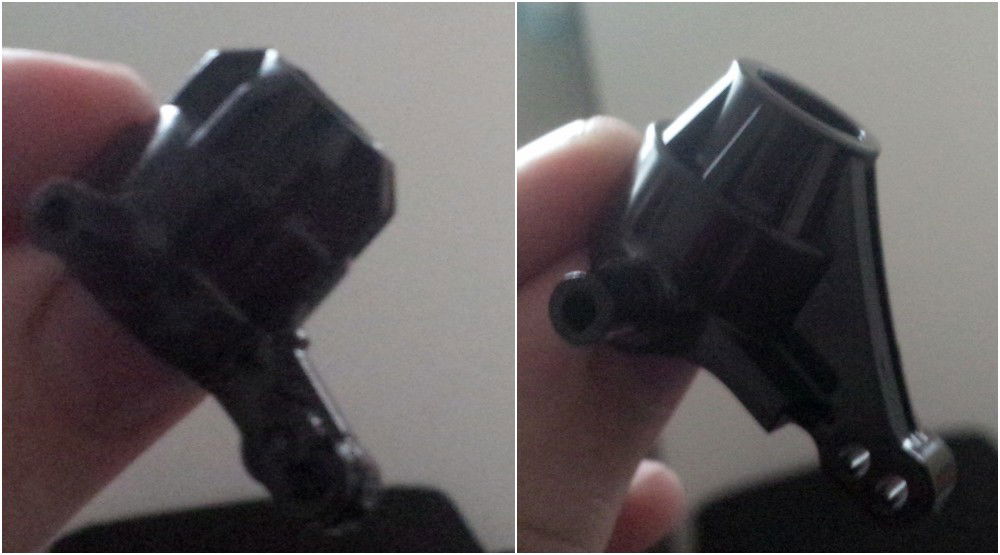
Speaking of which, AWR's season. Sam Green, after being one of the first "signees" Sam had left and created his own "GreenGP" outfit. AWR swelled up through the season, providing almost half the grid though 6 cars in the final round and constantly fielding 3 or more drivers. If it wasn't for a head-on hit with the wall in the last round, Alistair would have likely finished 5th ahead of Sam Green who had been reeled in as GreenGP was out-developed, but, because of the crash of the T.O.P. Racing Photon, Chris Strickland leapfrogged the pair of them, essentially beating his boss. AWR also almost won overall at Round 2 when the "Flying Irishman" Matt Scott stunned the grid.
Everywhere you looked, changes and upgrades came in on a weekly basis. Brushless motors, faster servos, weight saving, adjustment to car balance and suspension hardness, all the factors F1 teams look for on rack was evident just in this one assembly hall and it created a fluid hierarchy from event to event as certain cars were better tuned in to certain circuit types.
Overall it had been a great year but the gap to the top now seemed impossible to bridge. With the hall now having it's seats always pulled out, this had made the tracks much more tight and twisty than they had been in first year, and this had brought up some weaknesses in the TT-01's handling as it didn't respond well or carry the corner speed needed when going through hairpins which were more common place from second year onwards. This called for a drastic change which would change the TT-01 forever.
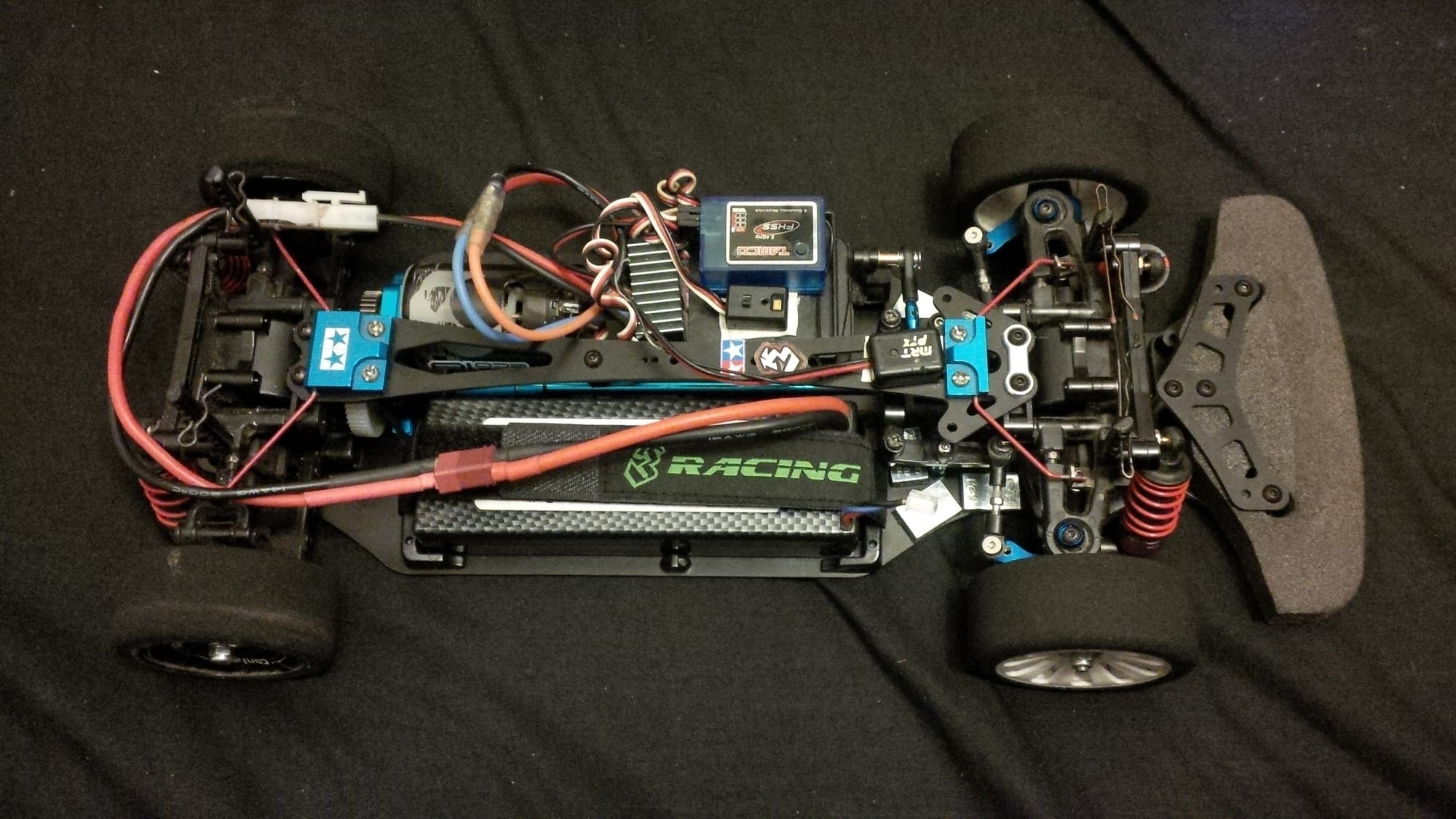
The 3Racing E35
3Racing are a Hong Kong RC company. They make their own cars which are on-par with most of the other top of the range offerings, but they also do conversion kits and “hop-ups” or upgrade parts for other manufacturers’ kits. One of those is the Tamiya TT-01. And after hours of forum reading and research, I came across two options, the E35 and E37 graphite and carbon fibre chassis.
Using the standard TT-01's mechanicals, the 3Racing conversion kit gave you a new, flat, stiffer floor and top deck, new differential housing, a new motor mount and front assembly. This made the car lighter and, importantly, more rigid. Deciding to save myself £40, I went for the E35 kit and within a couple of weeks it had arrived and I had torn my TT-01 apart and rebuilt it into its new form.
A test meeting in Alton a couple of months later helped me balance the car which was hugely altered from the original TT-01. The car now had no understeer at all in the chassis, at all, so I had to adjust the anti-roll bar and the tyres to stop the car having so much grip on turn in that it would either spin the back around or grip roll. But the car was obviously quick. A new HPI Firebolt 15 turn motor also gave the car a bit more top speed to keep up with the brushless competitors.
Round 1 of the ‘Winter Championship’. The E35 was immediately quick, a close 2nd place in its first quali race, a victory in the next, both against Dr Ash’s Schumacher Mi5, but disaster struck in quali 3. Coming into the final corner there was a marshal post on the left jutting out. I ran wide and the left rear wheel hit it and snapped the wishbone away from its slot on the differential. The damage was bad and it was impossible to find replacement parts on the E35 kit, plus, you couldn’t re-fit the old TT-01 diff housing. With about four gallons of contact adhesive we managed to patch the broken diff-housing back together, but it got to me.
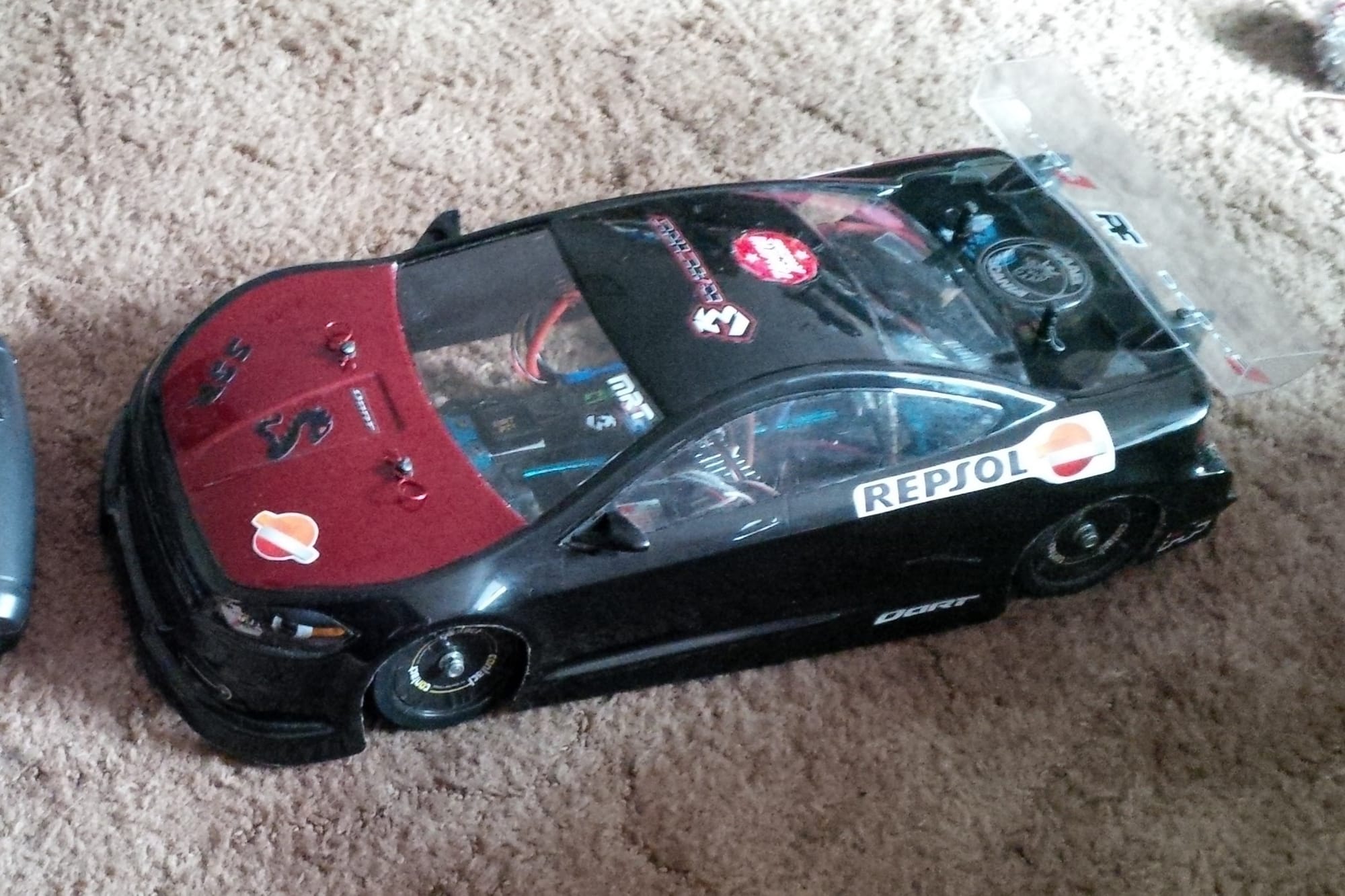
Despite being on pole position, I was cautious, I didn’t want to risk the part breaking again and potentially scrapping the whole chassis. I finished 2nd overall. Had this accident not happened, I genuinely feel the E35 could have mounted a championship attack, but, as it would turn out, it wasn’t meant to be.
Out of fear more than anything else, I decided to take drastic action, I added wheel guards to the chassis (below). These acrylic wings in front of the rear wheels saved the car but largely destroyed the handling. Weighing 30.17g, they weren’t hugely heavy, but they added that weight to the extremities of the chassis. This meant they increased the lateral forces every time the car turned, meaning the car was slower to react to inputs and lost a lot of its ‘darty’ handling.
This was made worse when I crashed my new Protoform Dodge Dart bodyshell at round 2. Believing the damage to be too severe to fix (incorrectly as it later turned out), I had to go back to the ‘Feerari EXX’ shell I’d used in previous seasons. It took me the remainder of the year of testing, adjusting and begging for it to work. I ended up 5th in the standings, behind two rookies, James Head and Ryan Clabdon, and with less than half the points of Dr Ash who won comfortably.

The Final Stand
All of a sudden, I now faced my final UHRC Championship campaign, the ‘Spring Championship’ of 2016 and it was all or nothing for the TT-01 E35.
The last changes I made to the car for this campaign were in aerodynamics and power. On the aero side, I bought Alistair’s unused Honda NSX body shell he had lying around and added the Dodge Dart’s high downforce rear wing. This was to make a marked improvement to the rear stability of the car over the EXX and it was necessary too, because I also changed from a brushed to a powerful brushless motor to give, at last, the E35 equal power to its competitors.
I knew with the guards still on the TT-01 wasn’t going to beat a now fully developed and in-form Dr Ash with his Schumacher Mi5, but I was determined to compete for the top 3. And despite the odds, it did.
Third place overall in the opener followed by 3 quali wins and another 3rd place at round 2 showed the car was back up to a fighting pace. Had everything been normal, the SSR Tamiya TT-01 3Racing E35 would have gone on to finish 2nd overall that year, a long way behind the dominant Dr Ash but clear of the rest of the field, but for one thing, the agreed new rule for a point for fastest lap in the finals.
Full credit to Ryan Clabdon here. He raced hard and fair and, in his new Schumacher Mi1 v2, he was naturally quick. I do feel bitter though, because when all was said and done after 8 meetings, Ryan beat me by 1 point, earned by getting fastest lap at that last race of the year, adding to the 7 out of 8 fastest lap points he won over the championship.
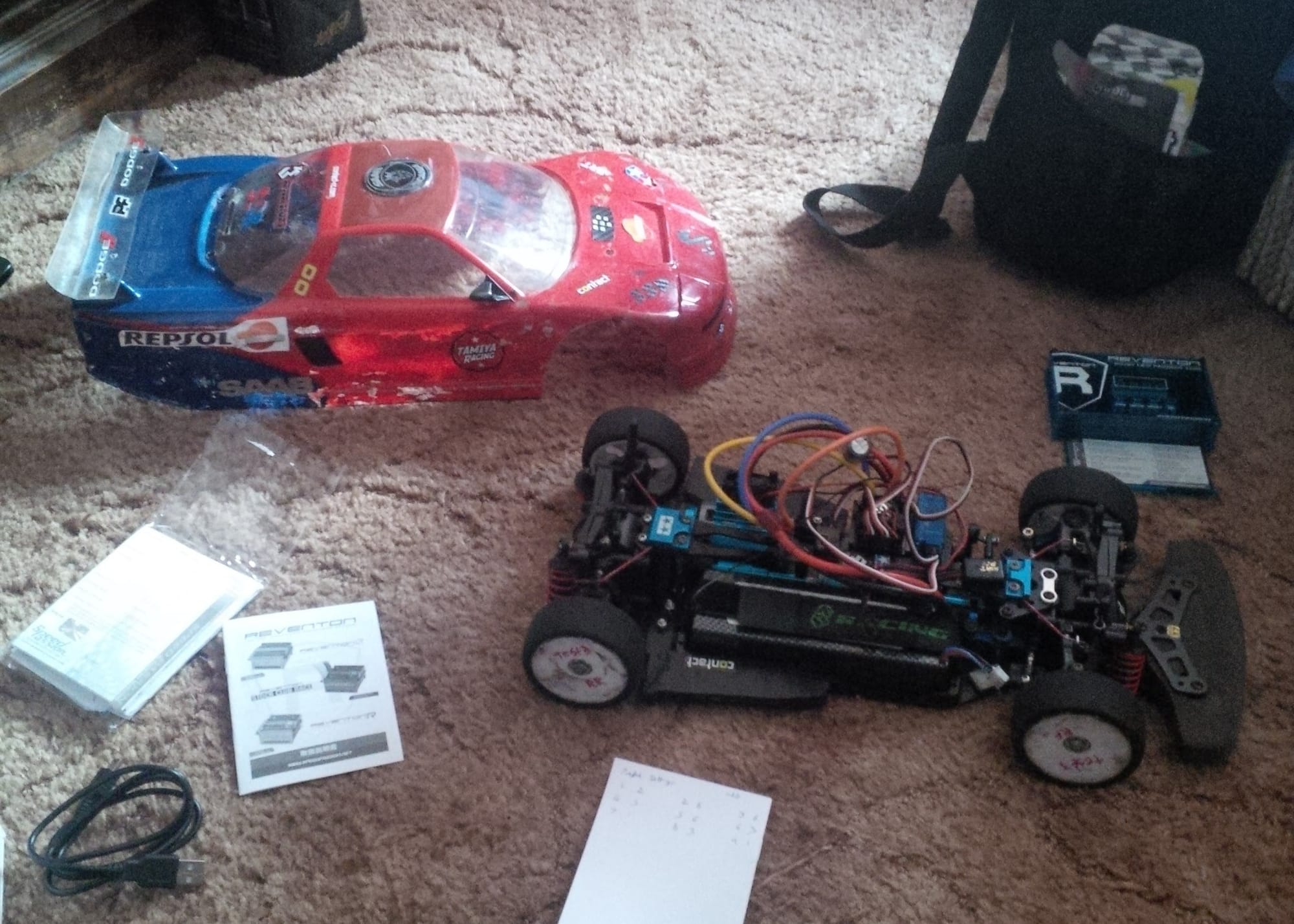
The Long Goodbye
A couple of months passed by, I completed my University degree, went back home and put my TT-01 on its shelf. Battered and paint chipped, the NSX shell has never been restored since its last outing of the ‘Spring Championship’. Eventually, Alistair told me about the racing club he had joined down in the West Country and in September 2016 I went down to Melksham to compete in a meeting at the West Wiltshire Model Car Club.
This was where the difference between my TT-01 and “proper” racing RC cars became evident. Melksham’s tracks are approximately 50% bigger than the tracks we were used to racing on at UHRC with wider, faster straights which allow cars to reach their top speed. My TT-01, even with its smallest spur gear and biggest pinion that can physically be fitted to the car, is no match.
I tried everything. I even found a supplier for the differential cases so I could finally take off the wheel guards, giving the car back the sharp edge in handling it once had. But, cruelly, that handling advantage into corners has almost no effect on the wider, open, flowing tracks of the WWMCC compared to what it would have had at UHRC. This realisation of the TT-01’s limits lead to me pulling the plug on the car’s racing career in March of 2019.
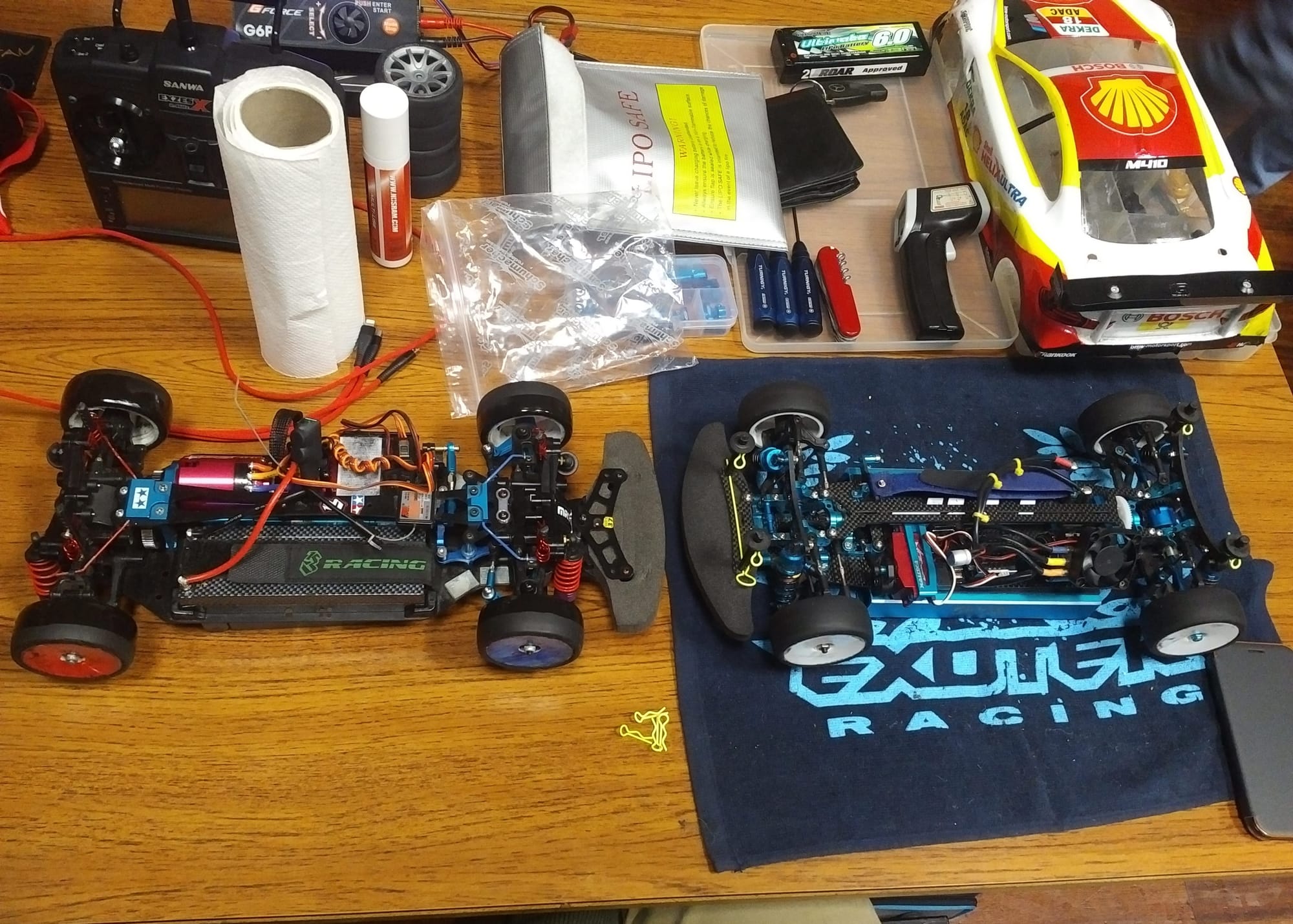
So, I guess that just leaves me to do a car review, 3,300 words in. The Tamiya TT-01 is a cheap, easy to drive RC Touring car. It has a range of upgradable parts from suspension to differentials, to the entire chassis as was the case with the 3Racing E35 conversion kit. The stock car is predictable but tends to understeer as the chassis suffers from flex and roll meaning cornering is lazy but controllable if you learn how to pitch it in properly to get the back-end unsteady and powering through the corner. Parts are readily available and very cheap and, for anyone wishing to start out, it makes a fantastic car to learn on and push to its limits.
The E35, by comparison, is a very interesting hybrid. The graphite chassis makes the car a lot stiffer and it has a very positive front end where the nose of the car will go right where you want it to, often causing the back to go loose and potentially spin. This can be dialled back but in its optimum form, the E35 handles almost as well as any carbon fibre, fully designed touring car.
The one issue it has is the availability of parts if any of the conversion kit bits break. It also still suffers from the TT-01's Achilles’ heel which is the 0.6-mod Tamiya gearing. The smallest spur gear I have ever found is 52 teeth and the biggest pinion I have managed to find and fit is 30 teeth, Any bigger on the latter and the motor mount gets in the way, meaning a higher top speed is impossible. This gearing just doesn’t have the top-end of the ‘proper’ RC racing cars and, as much as you may try, this problem is almost unfixable.

Other annoyances are that the method of attaching the rear differential to the prop shaft and thereby the front wheels is infuriating, the steering rack hits the drive shaft when turning, parts break a lot, the car doesn’t like being pushed beyond its limits and it has a tendency of ripping its spur gear to pieces when in a crash, be it your fault or otherwise.
That said, I love it. My TT-01 is a fantastic car which has a huge amount of character, It embarrassed cars which cost 5 times more than it did, because it was easy to drive and adjust and because that adjustment was limited, if something was wrong, you often knew what it was and how to go about fixing it. It may have still been stressful, but it was often cheap and easy to do anything you wanted to the car to keep it on track or find that last available tenth of a second.
But, at the end of the day, racers need to move with the times and eventually, all things have to come to an end. My TT-01 has been reverted back to the final form it took at UHRC with its ultra-powerful brushless motor and foam tyres. If I ever choose to, I may take it out to Alton again, or maybe even do some demo laps around the outdoor track I now race at in Aldershot, but otherwise, it sits on its special shelf, locked away like a museum piece. It was a great car and brought me a lot of happiness, for which it will never be forgotten. The new cars which will follow it have some high stats to compete against.
Actually, on second thoughts, I could stick a 13.T motor in and see how it fairs outdoors...

SSR Tamiya TT-01 3Racing E35 Combined Summary
183 Race Starts
37 Wins
20.2% Success Rate
£540.15 Total Cost (including transferable parts such as motors, controllers and batteries)
Biggest Achievement – 3rd Place Overall at the UHRC ‘Spring Championships’ in 2015 and 2016
Highest Overall Meeting Result – 2nd x2
Weight – 1,342g
Top Speed – 26.5mph (18.2mph using a 17.5T motor)
Review Score – 7.5/10

Stelvio Automotive – Article 75 (Part 2) - @StelvioAuto
